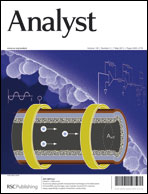Incorporation of deuterium oxide in MCF-7 cells to shed further mechanistic insights into benzo[a]pyrene-induced low-dose effects discriminated by ATR-FTIR spectroscopy†
Abstract
This study evaluated the potential of deuteration to enhance the mechanistic information obtainable by biospectroscopy techniques in biological-cell models. These techniques were previously demonstrated to identify low-dose effects (≤nM) induced by test agents; this is of critical interest in terms of developing novel approaches to monitor environmentally-induced cell alterations. Attenuated total reflection Fourier-transform infrared (
![Graphical abstract: Incorporation of deuterium oxide in MCF-7 cells to shed further mechanistic insights into benzo[a]pyrene-induced low-dose effects discriminated by ATR-FTIR spectroscopy](/en/Image/Get?imageInfo.ImageType=GA&imageInfo.ImageIdentifier.ManuscriptID=C3AN36721E&imageInfo.ImageIdentifier.Year=2013)

 Please wait while we load your content...
Please wait while we load your content...